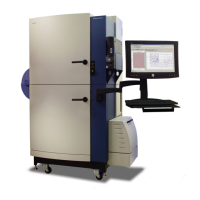FLIPR
®
Tetra High Throughput Cellular Screening System User Guide
0112-0109 H 243
Transfer Fluid Processes
In general, settings for transferring fluids in remote control are the
same as in manual mode—with three exceptions. These are in
aspiration height over multiple plates, and the Pause In Well edit box.
Aspiration Height over Multiple Plates
When running in remote mode, a user may wish to use a common
addition source plate over a series of plates. The protocol(s) for this
may be done in a couple of ways. The simplest way to do this is to
create a single protocol which aspirates from the lowest allowed point
in the source well. When doing this, the user will have to determine the
maximum amount of liquid in the well so that the liquid displaced
during insertion of the tip into the well is not pushed out of the well.
This will limit the amount of liquid that can be used in the source well.
Alternatively, the user may choose to create a series of protocols at
successively lower aspiration start levels.
To provide an example of this situation, consider a user using a 384
well plate with a 250 μL well. This source plate is used to add a
common agonist to all wells. In the assay, 20 μL of this agonist is
added. The user would like to leave the plate in the instrument for a
series of plates before replacing it. The FLIPR
®
Tetra System a
instrument will allow protocols which begin aspiration as low as 8 μL for
this plate. Inserting a 384 well tip all the way to the bottom of this plate
will displace 50 μL of liquid.
In the simple method described above, the user should not start with
more than 190-200 μL of liquid in the plate because any more than this
may spill liquid when the tip is fully inserted. The single protocol would
begin aspiration at 8 μL height. They could then run this assay 9 times
before replacing the plate; leaving 10–20 μL of liquid in the wells after
the source plate is removed.
In the more complex implementation, the user may wish to fill the wells
to 230–240 μL. They would then set up an assay that would start
aspiration at ~240 μL in height, a second assay to start at ~220 μL, a
third to start at ~200 μL. The user could continue to create separate
assays at different heights or use the third assay for the remaining
plates. In this case, 11 plates can be run before the plates need to be
changed.
The simple method is simpler to setup and run. The more complex
method allows source plates to be switched less often. It also decreases
the proportion of wasted common reagents. Finally, it may decrease
carryover of compounds sticking to the outside of the tips, especially if
the protocols are created to retrieve liquid from progressively lower
heights all the way through the well height.

